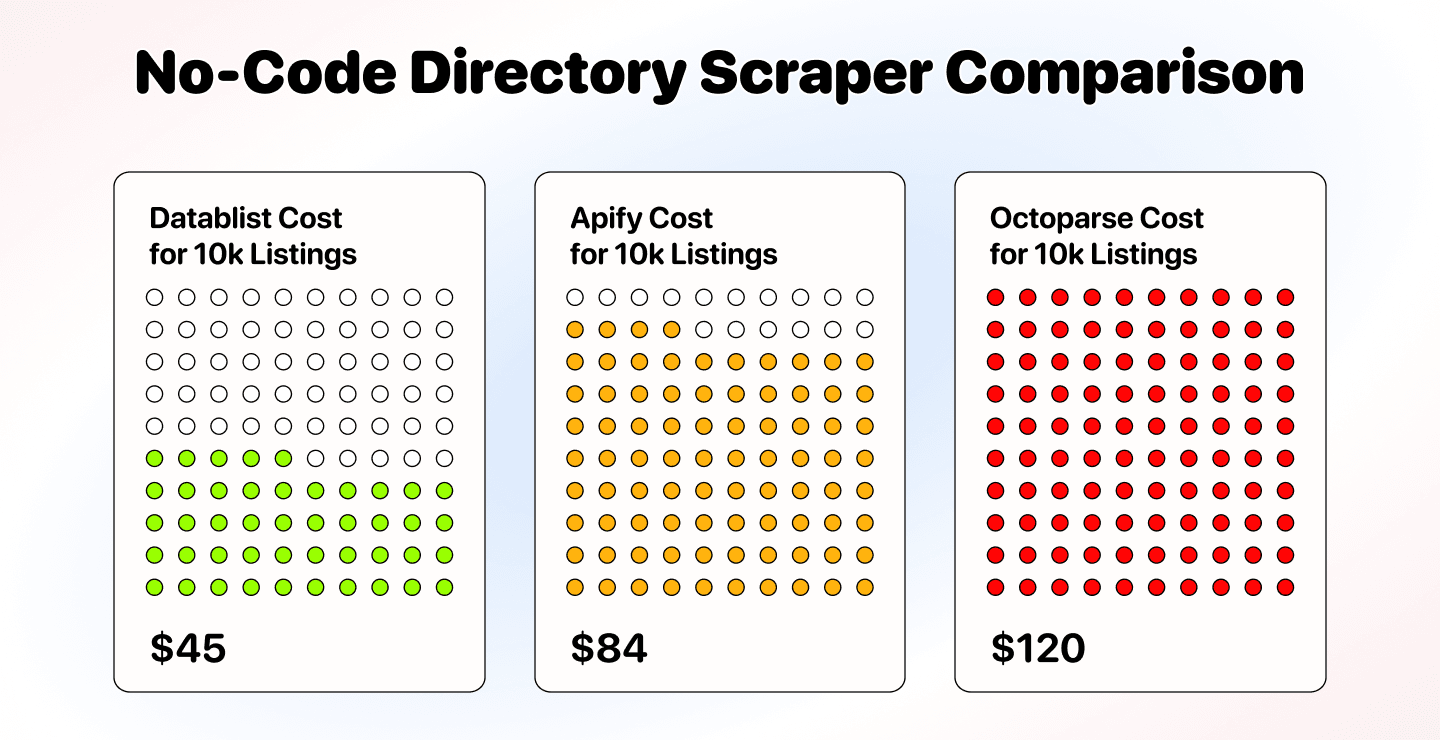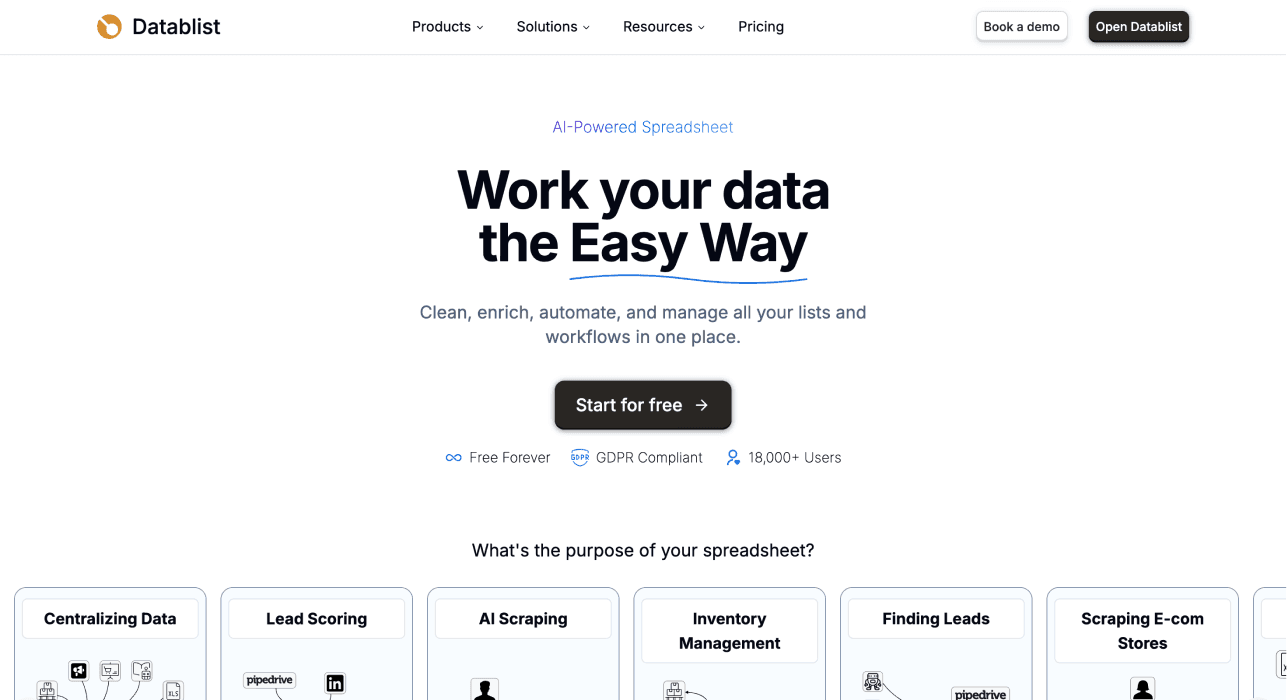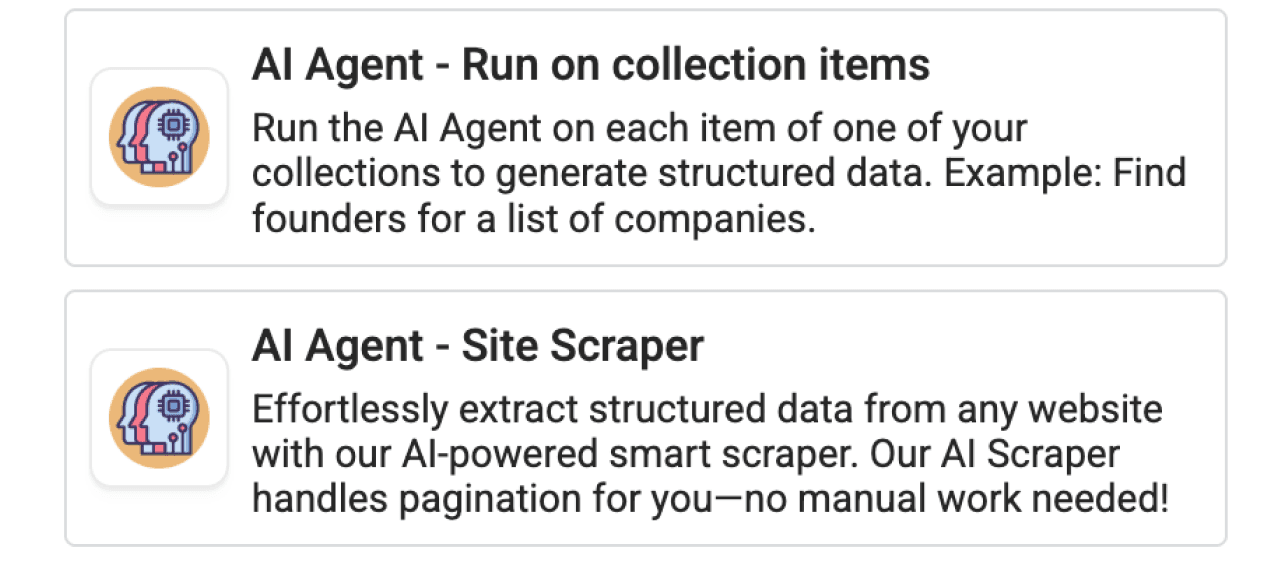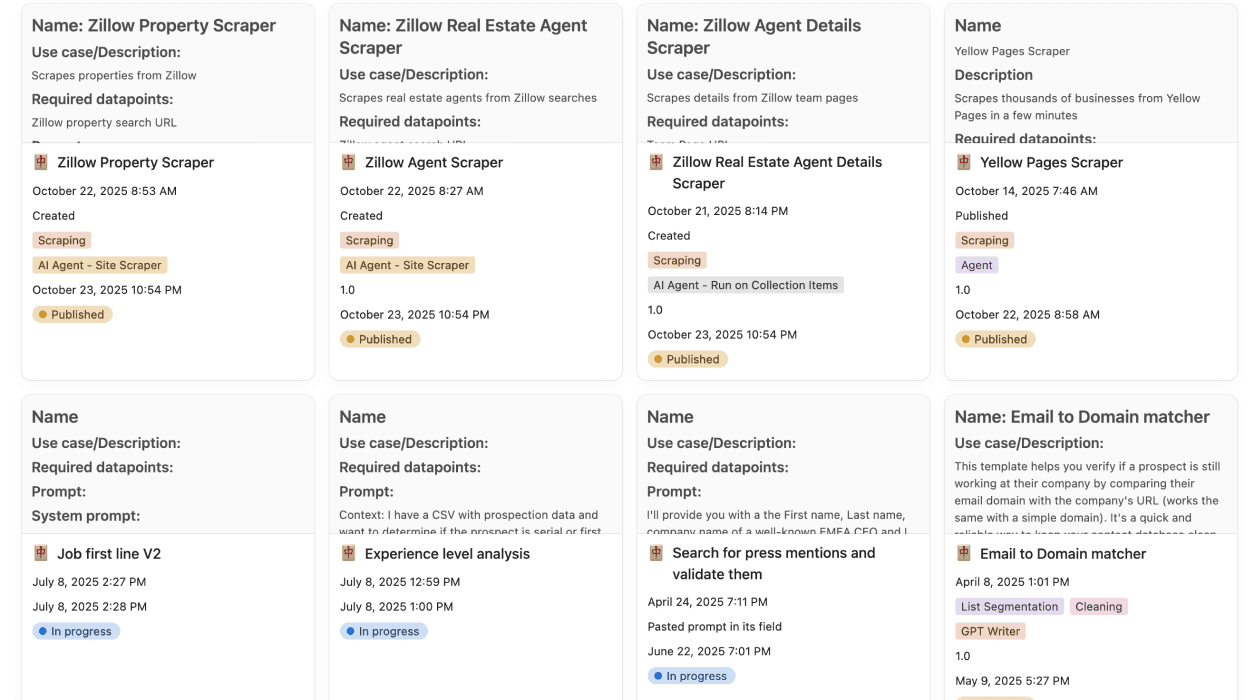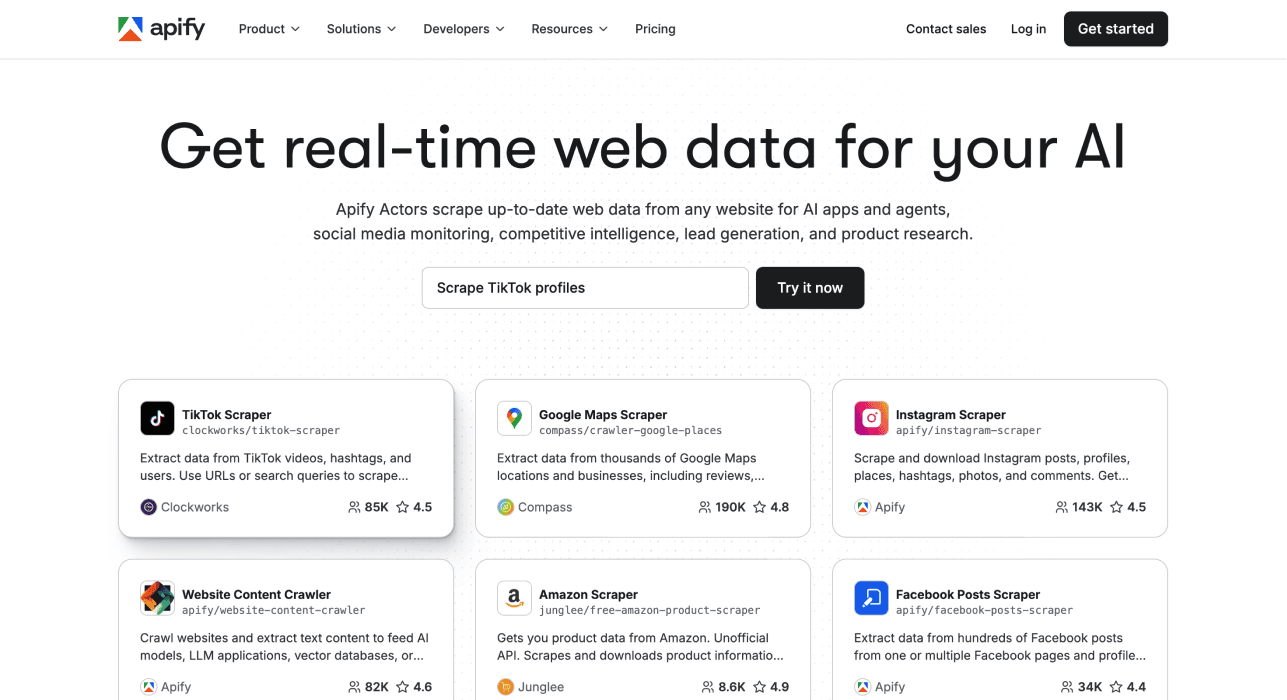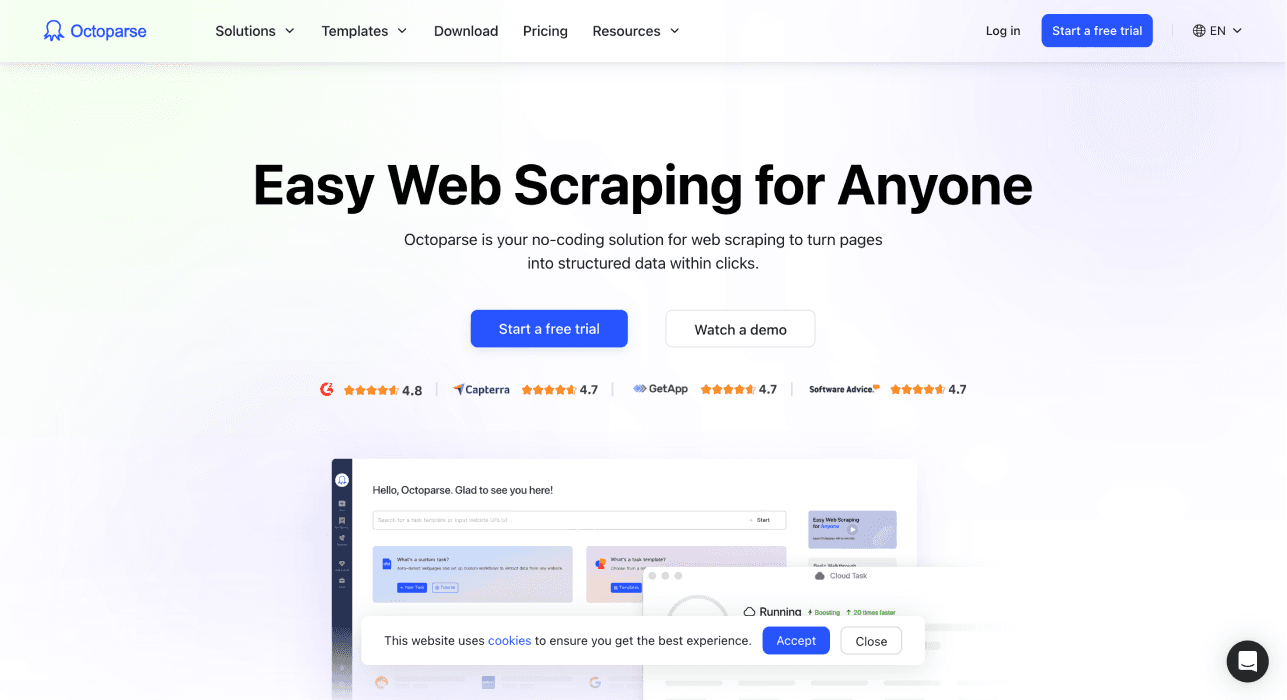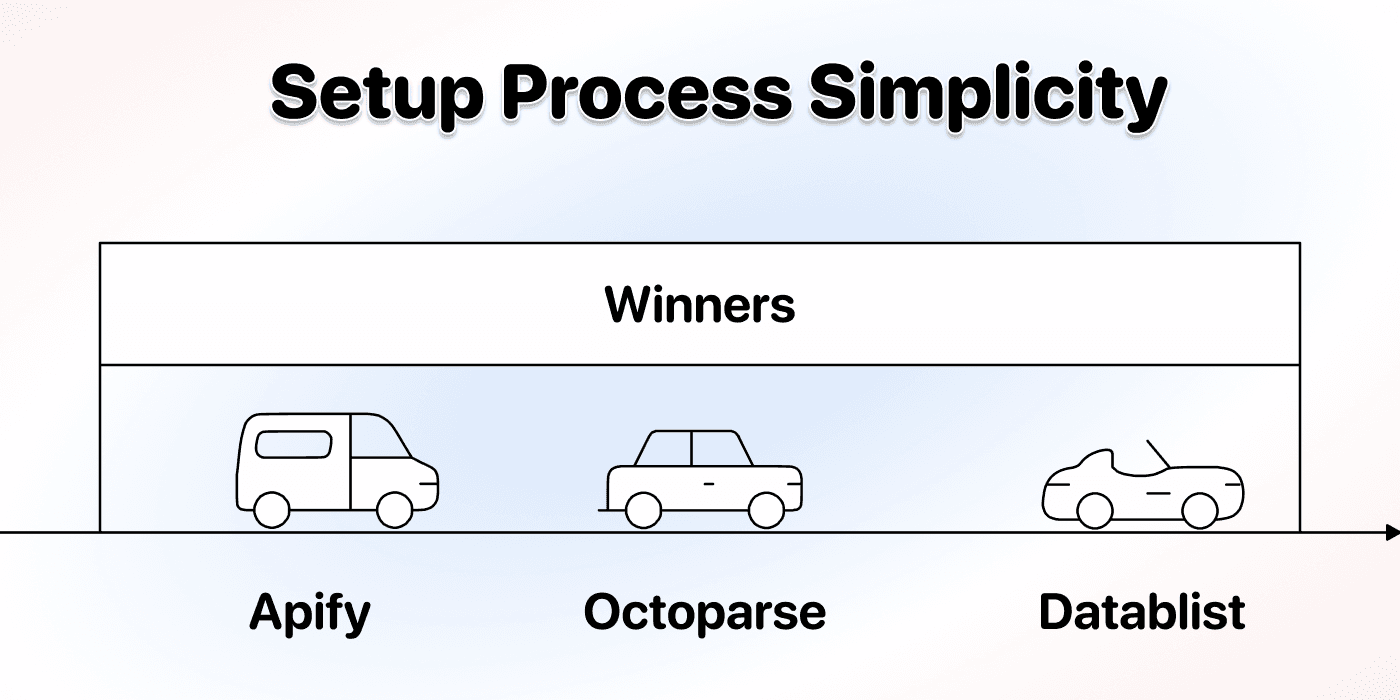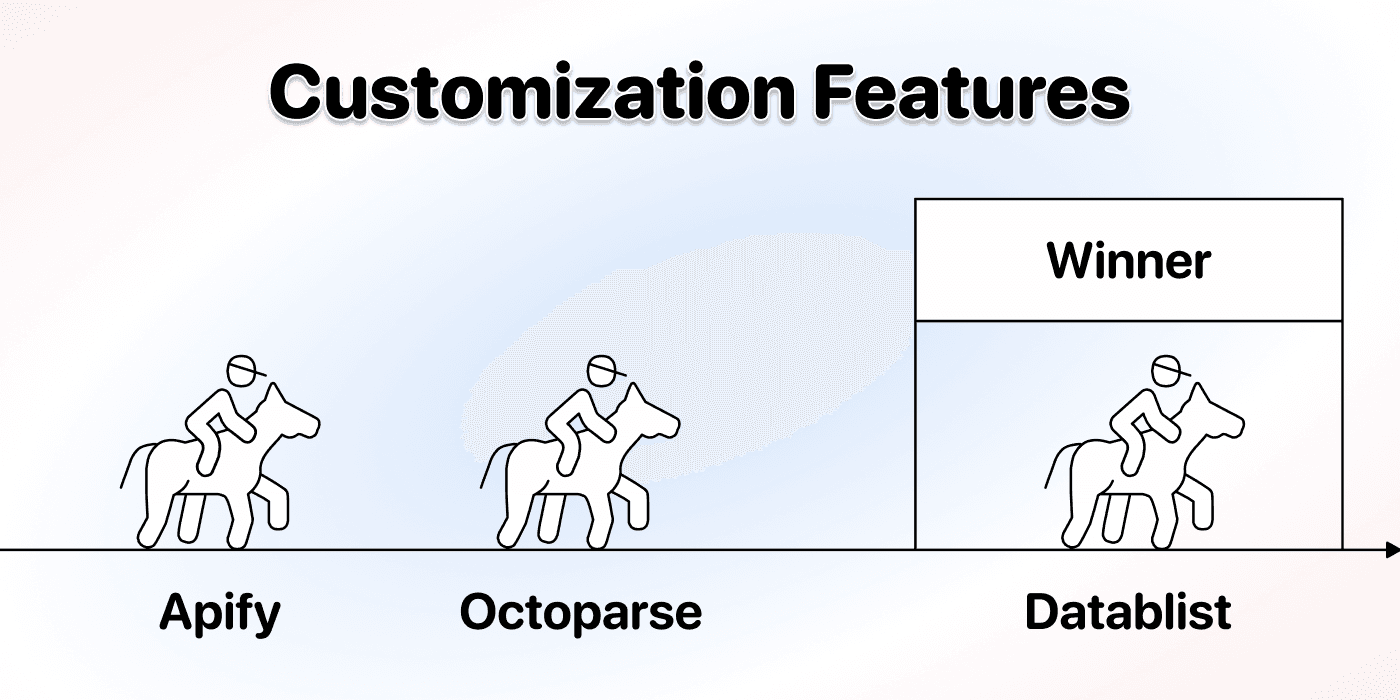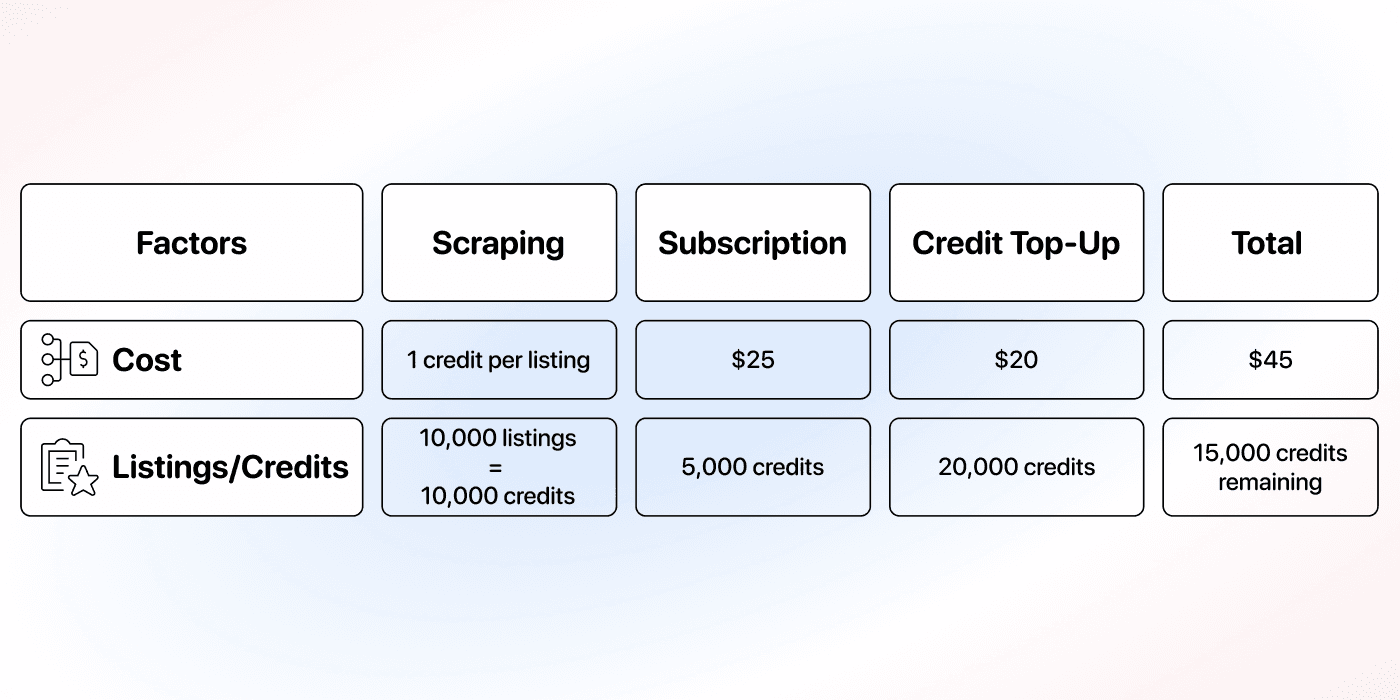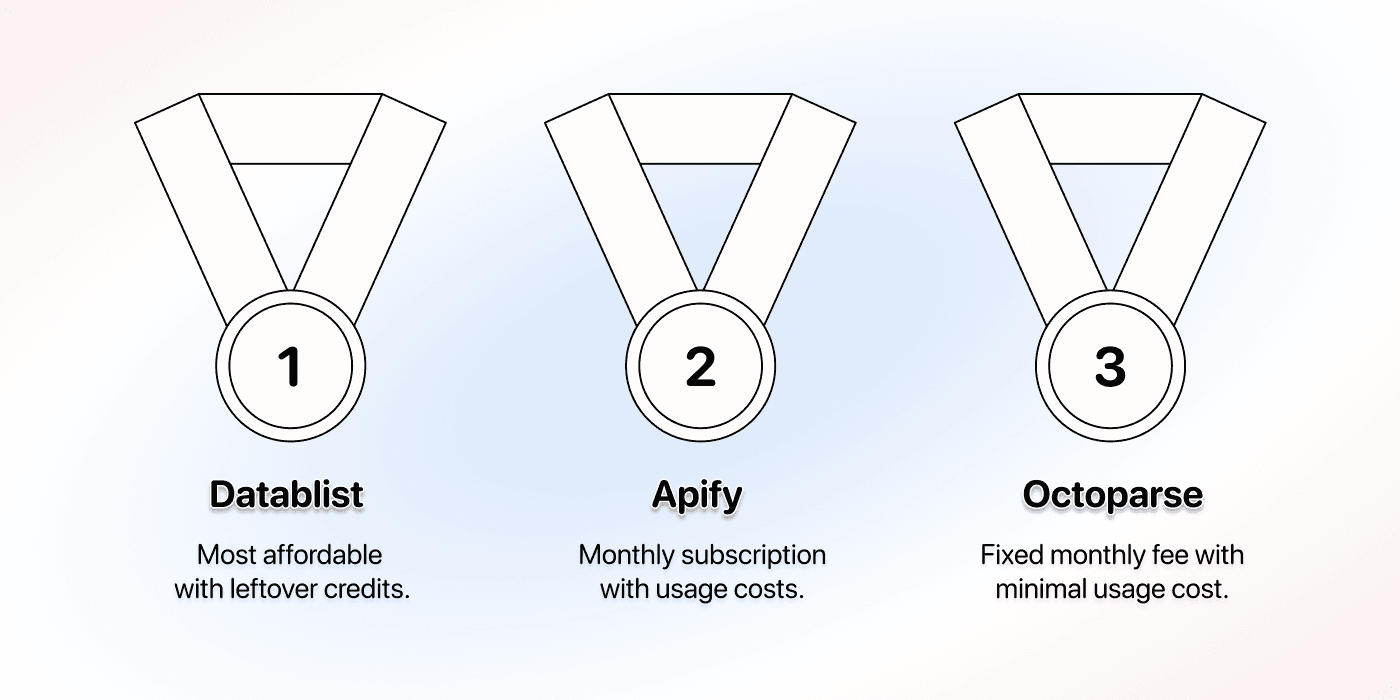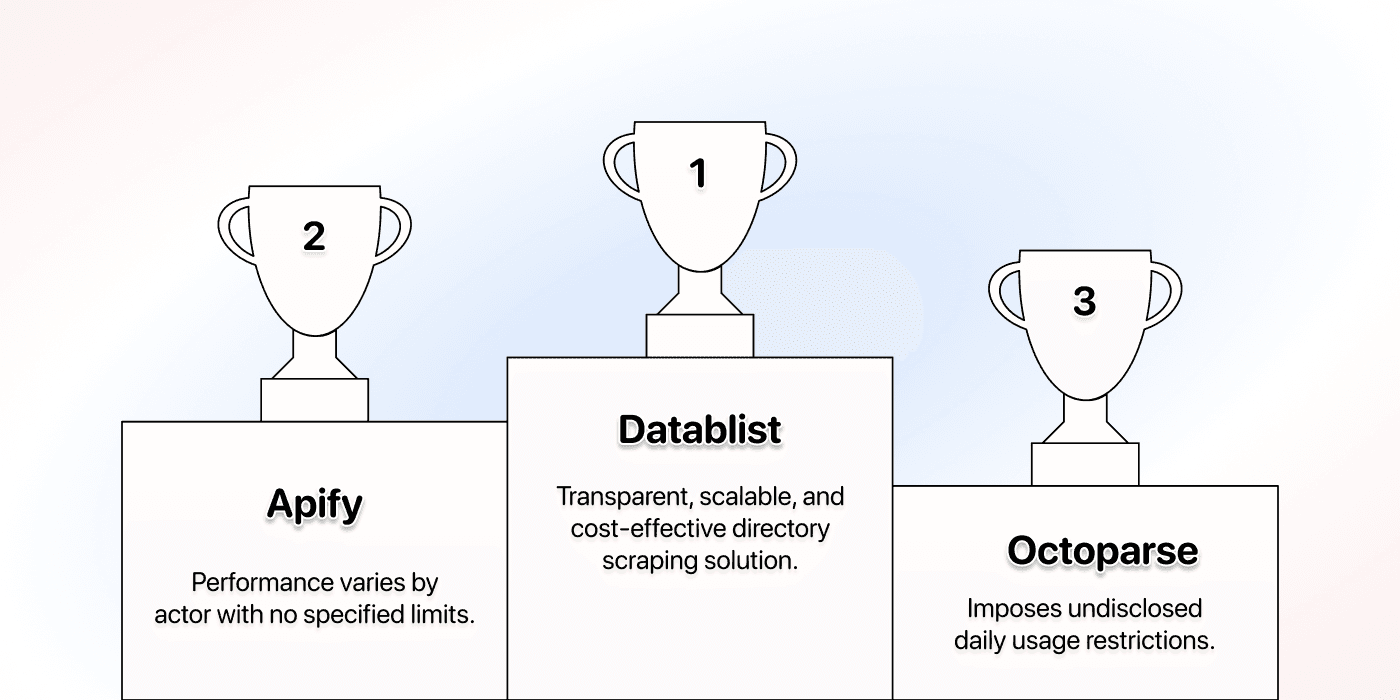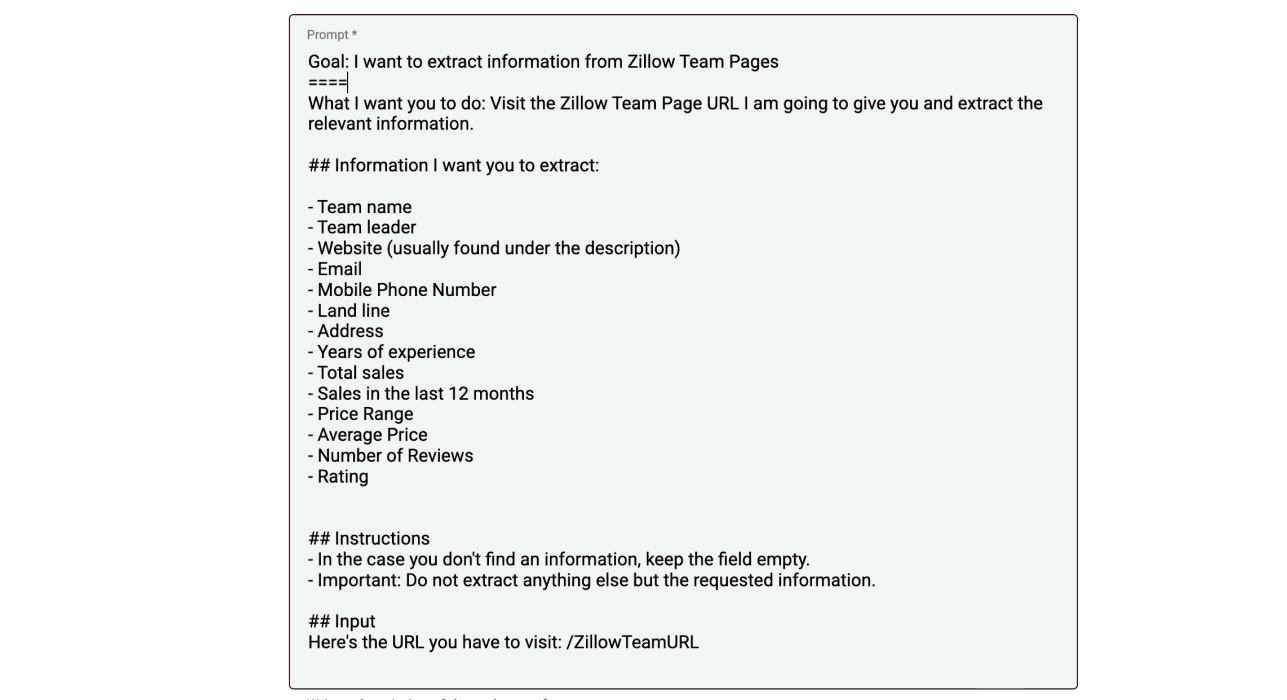Code vs. No-Code isn’t really a question we ask ourselves, but which no-code scraping tool should it be? Because not all no-code tools are equal.
Some are easy to use and affordable. Others are not affordable at all. And the worst part? Most comparisons don't tell you the full story because they focus only on promoting their own tool.
While we also want to promote our tool, we are honest and humble. Additionally, we calculated actual costs and compared the three best no-code directory scrapers in a head-to-head.
With that being said, let’s skip the hot air and move to the facts
📌 Summary For Those In a Rush
This article compares the best no-code tools for scraping directories in 2025. If you are in a rush, here is a summary:
The Problem: Scraping directories should be easy and affordable, but most tools require either a PhD in tech or a government-level budget.
The Comparison: We tested three no-code tools (Datablist, Apify, Octoparse) on Yellow Pages scraping to see which delivers the best value.
Key Findings:
- Datablist wins on pricing ($45 for 10k listings vs $124+ for competitors)
- All three have similar setup processes (select template, configure, run)
- Datablist offers full customization without contacting support
- Only Datablist includes an entire lead generation ecosystem
- Octoparse wins on video tutorials
- Apify wins on community and variety
Bottom Line: If you want to scrape directories without breaking the bank or learning complex tools, Datablist is your best bet at $25/mo.
What This Article Covers
The 3 Best No-Code Directory Scrapers at a Glance
| Tool | Best For | Starting Price | Cost for 10k Listings | Wins On |
|---|---|---|---|---|
| Datablist | Users who need customization and lead gen tools | $25/mo | $45 total | Price, flexibility, lead gen ecosystem |
| Apify | Variety of pre-built scrapers | $39/mo | $84 total | Scraper marketplace |
| Octoparse | Click-and-point interface fans | $119/mo | $120 total | Visual interface, tutorials |
Datablist: The Most User-Centric Lead Generation Platform
Datablist isn't just a scraping tool. It's an entire lead generation ecosystem that happens to include powerful scraping capabilities.
What makes Datablist different is simple: it was built for non-technical users who need to find, enrich, and use business data without juggling multiple platforms.
📘 Datablist Summary
Best For: Non-technical users who need directory scraping plus lead generation tools (emails, phone numbers, enrichment)
Wins On: Price ($45 vs $120+), customization without technical knowledge, complete lead gen ecosystem
Starting Price: $25/month with 5,000 free credits
Overview of Datablist
Datablist combines AI scraping with over 60 data cleaning and enrichment tools in one platform. You can scrape any directory, find emails and phone numbers for the listings, clean duplicate entries, and export everything to your CRM or sequencer without leaving the platform.
Key Features
AI Scraping Agent
The AI Agent understands plain English instructions. Tell it what data you want from a directory, and it figures out how to extract it. No CSS selectors, no clicking on elements, no technical knowledge required (that’s what no-code is about)
Beyond no-code scraping, you get:
- Waterfall Email Finder for verified business emails
- Mobile Phone Number Enrichment for direct contact
- Technology Finder to see what tools companies use
- AI Research Agent for deep company insights
- Advanced Deduplication to clean your lists
- Automation tools to build workflows
Best Tool to scrape a directory
Ready-to-Use Templates
Pre-built scrapers for Yellow Pages, Google Maps, Zillow, Airbnb, and many more. Each template is fully customizable using plain English if you need different data points.
Starting at $25/month
What you get:
- 5,000 free credits (every month)
- Access to all 60+ tools in the platform
- Flexible credit top-ups (no plan upgrades needed)
- Advanced automation capabilities
- Fast support (whenever needed)
Real Cost Example:
Scraping 10,000 Yellow Pages listings costs approximately 10,000 credits.
With your $25 subscription (5,000 credits) plus a $20 credit top-up, you invest $45 total.
You'll still have roughly 15,000 credits left for finding 600 emails or running 3,000 technology enrichments.
Pros
Easiest Setup
The Yellow Pages scraper is fully configured out of the box.
Select the template ⇒ Set your limits ⇒ Run. That's it.
Fair Pricing
At $45 to scrape 10,000 listings (including leftover credits for enrichment), Datablist is priced at half the cost of Apify and about 38% of the cost of Octoparse.
A Lot of Templates
Pre-built scrapers for the most common directories and websites, all customizable.
Can Handle Large Scale
Scrape up to 100,000 listings per collection. Need more? Create another collection and keep going.
Cons
Fewer Templates Than Octoparse
While Datablist has many templates, Octoparse has built more over the years. However, Datablist's AI Scraping Agent can scrape custom directories that Octoparse doesn't support.
Best For
Users who need to find company data and contact information after scraping. If your goal is to build lead lists for outreach, not just collect raw data, Datablist gives you everything in one platform.
💰 What Harry Has to Say
“Datablist’s workflows cut repetitive tasks in half and freed up focus for our GTM strategy.
The time saves helps us do double the list building we could of done previously, effectively doubling our capacity. Allowing for an increase in $5,000 MRR.
Huge thanks to Habib for the effortless onboarding and 1:1 support!”
Apify: The Scraper Marketplace
Apify is a marketplace of pre-built "actors" (individual scraping scripts) for specific websites. Think of it as the Android app store for web scraping.
📘 Apify Summary
Best For: Tech-savvy users who need variety and don't mind potential complexity
Wins On: Variety (1,000+ actors), managed infrastructure for developers
Starting Price: $39/month plus actor, GPU, proxy, compute units, and data transfer fees
Overview
Instead of building scrapers in-house, Apify lets developers publish their scrapers for others to use. This creates incredible variety but also introduces quality inconsistencies since most actors are maintained by outside creators, not Apify.
Key Features
Scraper Marketplace
Over 1,000 pre-built actors for almost any website you can imagine. From social media to e-commerce to directories, there's probably an actor for it.
Building Platform With Proxies
For technical users, Apify provides infrastructure for building custom scrapers using JavaScript. Includes proxy management and anti-bot protection.
Professional Scraping Services
Apify offers custom scraping development if you can't find an actor that meets your needs. This comes at a premium price.
Pricing
From $39/month
What you get:
- Access to the actor marketplace
- $39 to spend on the Apify marketplace
- Cloud-based execution
But here's the catch:
Each actor has different pricing. The best-rated Yellow Pages scraper charges a $25 rental fee to the developer on top of Apify's platform costs.
Pros
Scrapers for Everything
The marketplace variety is unmatched. If a website exists, someone has probably built an actor for it.
Managed Infrastructure for Developers
If you're technical, Apify handles servers, proxies, and scaling so you can focus on building scrapers.
Easy to Start
Finding and running a pre-built actor is straightforward. The interface is clean and well-organized.
Cons
Most Scrapers Are Not Built by Apify
Community-created actors can break when websites change. Support depends on the creator's availability and responsiveness.
Cost Seems Good at First, But Is Quite Complex
Between all platform fees, actor rental fees, usage, and infrastructure costs, the final price can surprise you. More on this in the pricing comparison section.
No Customization Possible
If an actor doesn't extract exactly the data you need, you're stuck. You can't modify community actors without building your own.
Best For
Users who need a variety of scrapers and are comfortable with some tech. If you don't mind reading documentation and troubleshooting occasional issues, Apify's marketplace offers unmatched breadth.
Octoparse: The Click-and-Point Pioneer
Octoparse pioneered visual web scraping with its point-and-click interface. It's genuinely no-code in the sense that you don't write any code, but you do need to understand how websites are structured to extract target information.
📘 Octoparse Summary
Best For: Users who prefer visual click-and-point interfaces
Wins On: Template library, tutorials, and documentation
Starting Price: $119/month
Overview
Octoparse uses a desktop application where you click on website elements to teach the scraper what data to extract. It's visual, relatively intuitive, and backed by extensive tutorials and documentation.
Key Features
Click-and-Point Scraping
Open a website in Octoparse, click on the data you want, and the tool learns the pattern. No coding required, but you do need to understand HTML structure to select the right elements.
Automation
Cloud-based scraping lets you schedule tasks to run automatically without keeping your computer on.
Large Template Library
Pre-built templates for popular websites and directories. Each template is ready to use with configuration options for your specific needs.
Pricing
From $119/month
What you get:
- Desktop application
- 100 tasks per month
- CAPTCHA solving
- Automation features
- …
Pros
A Lot of Templates
Octoparse has built templates for years and offers one of the largest libraries of pre-configured scrapers.
A Lot of Tutorials
Extensive documentation and video tutorials make learning easier.
Has an Auto-Detect Feature
Octoparse can automatically detect common data patterns on pages, which speeds up setup for structured directories.
Cons
Must Install Desktop App
No web-based option. You have to download and install software on your computer, which adds friction.
Quite Expensive
At $119/month minimum, Octoparse prices out many individual users and small teams.
No Customization Possible Without Support
If you need data fields that aren't in the template, you have to contact support for help or rebuild the scraper manually.
Best For
People looking specifically for a click-and-point interface. If you want a visual tool and budget isn't a concern, Octoparse delivers a polished experience.
Head-to-Head Feature Comparison of The Best Tools to Scrape a Directory
Let's test these three no-code scraping tools on the same real-world task: scraping Yellow Pages. This is the simplest and most popular directory people want to scrape, which makes it perfect for comparison.
Setup Process
All three tools use the same methodology:
- Select a Yellow Pages template
- Configure your search parameters and limits
- Run the scraper
Winner: Tie (All Three)
The initial setup is equally straightforward across all platforms. You're not learning complex interfaces or writing code. Just configure your search parameters and go.
Templates are great, but not everyone needs the same data, which is common sense, right? For some people, firmographic data matters; for others, contact information is crucial. Therefore, you should be able to specify the data points you want.
Datablist's Yellow Pages Scraper
Fully customizable using plain English. The template includes all standard data points (business name, address, phone, website, categories). Want something different? Tell the AI Agent what you need.
Example: "Also extract the year established and number of employees if shown on the listing page." The AI understands and adjusts automatically.
Apify's Yellow Pages Scraper
Not customizable through the interface. The actor extracts a fixed set of data fields. If you need different fields, you're stuck unless you build your own actor (which defeats the purpose of no-code scraping).
Octoparse's Yellow Pages Template
Not customizable without contacting support. You can configure search parameters (location, category, limits), but not the extracted data fields. For custom fields, you need to either contact their support team or manually rebuild the scraper using the visual editor.
Winner: Datablist
Only Datablist offers true customization without technical headaches or support tickets. This matters more than you might think because every business has slightly different data needs.
Let's calculate the real cost of scraping 10,000 Yellow Pages listings.
Datablist
- Yellow Pages scraping uses approximately 1 credit per listing
- 10,000 listings = 10,000 credits
- Your $25 subscription includes 5,000 credits
- Buy a $20 credit top-up for 20,000 additional credits
- Total cost: $45
Bonus: You still have roughly 15,000 credits remaining for other tools (email finding, technology enrichment, scaling AI search, etc.)
- The most popular Yellow Pages actor costs $25 rental fee to the developer
- Platform usage for 10,000 listings costs approximately $40
- Your $39 monthly subscription
- Total cost: $124 minimum
Since you get $39 to spend with your subscription, the real cost would be $85
Octoparse
- Your $119 monthly subscription
- Scraping 10,000 listings costs $1 in usage
- Total cost: $120
However, you're paying $119 every month whether you scrape or not
Winner on Price: Datablist
At $45 total (with 15,000 leftover credits)
Datablist is: 1.9x cheaper than Apify & 2.6x cheaper than Octoparse
Most directories have hundreds of thousands of entries. If you want to do large-scale scraping projects, then you need a powerful scraper to do so. This section will compare how much each tool can handle before hitting walls.
Datablist
- Limit of 5,000 pages or 100,000 listings per collection (spreadsheet)
- Need more? Create another collection and scrape another 100,000
- Repeat until you've scraped everything you need
- No artificial restrictions
💡 Datablist Large Scale Advantage
With 100k records per spreadsheet, Datablist has one of the highest limits on the market.
Apify
- No specified limits for scraping directories
- Performance depends on the specific actor you're using
- Some actors handle large volumes better than others
Octoparse
- Mentions that complex websites have daily usage limits
- Doesn't specify exact listing limits publicly
- Limits vary by plan tier
Winner: Datablist
Clear, transparent limits that you can easily work around by creating multiple collections. You know exactly what to expect.
How responsive and helpful is support when you hit issues?
All the information seen here has been sourced from G2.
Datablist
Customers consistently praise the support team for being fast and helpful.[1] A user on G2 specifically highlighted how fast we solved a tough issue.
💰 Hear It From Dominick
Datablist helped me organize, enrich, and scale my lead database effortlessly. Customer support was top-notch. Solved a tough issue fast — I'm now a loyal customer for life.
Apify
Generally strong support, though one user mentioned they didn't like that support happens primarily via Discord. However, Apify also offers a help center and email support.[2]
Octoparse
Users consistently praise how fast the support team responds. The team is described as super friendly, super helpful, and genuinely caring about users[3]
Winner: Tie (All Three)
All three platforms offer quality support. Your preference might depend on communication style (Discord for Apify, traditional channels for Datablist and Octoparse).
Which One Is Best For Specialized Directories?
Here's something most comparisons don't tell you: Yellow Pages is the easiest directory to scrape. It has a clean structure, consistent formatting, and no login requirements.
What happens when you need to scrape a specialized directory? Let's say you want to scrape a niche industry directory specific to your market. Here's how each tool performs:
Datablist
The AI Agent handles it. As long as the directory doesn't require a login, you can scrape it by describing what data you want. The process stays just as easy as scraping Yellow Pages.
Apify
If an actor exists for your specific directory, great. If not, you're stuck unless you want to build one yourself (which requires coding skills).
Octoparse
You'll need to use the visual editor to manually configure a scraper. This means learning the tool, understanding HTML structure, and spending hours on setup. Much harder than Yellow Pages.
The bottom line: Datablist's flexibility shines when you go beyond common directories. The AI adapts to any site structure without you learning new skills.
By the way, here’s a guide that shows you how to scrape any directory 👈🏽
Datablist Let’s You Scrape Anything (including any directory)
If you don’t believe me, here are links to articles that prove it:
- Scraping businesses from Yellow Pages
- Scraping properties from Zillow
- Scraping properties from Airbnb
- Scraping products from Shopify stores
- Scraping case studies from websites
- Scraping real estate agents from Zillow
- Scraping companies from the YC startup directory
Conclusion: Which Tool Should You Choose to Scrape Directories?
After comparing setup, customization, pricing, scale limits, and support, here are some non-biased recommendations
Choose Datablist if:
- You want the best price-to-value ratio
- You need customization without technical know-how
- You plan to enrich data after scraping (finding emails, phone numbers, researching companies)
- You want one platform that handles your entire lead generation workflow
- You're scraping specialized directories beyond the common ones
Choose Apify if:
- You specifically need a scraper that only exists on their marketplace
- You're comfortable with technical tools and reading documentation
- Budget is flexible, and variety matters more than ease of use
Choose Octoparse if:
- You specifically want a click-and-point desktop interface
- You're scraping only well-known directories with existing templates
- Budget isn't a primary concern ($119/month is acceptable)
Frequently Asked Questions About Directory Scraping Tools
Are There Any Directories Datablist Can't Scrape?
Datablist can scrape any directory that doesn't require a login. If you can see the data in your browser without signing in, Datablist can extract it.
The only limitation is authentication. Directories behind member-only access or subscription paywalls need credentials, which Datablist's AI Agent doesn't support for security reasons.
For public directories (Yellow Pages, business listings, product catalogs, company directories), Datablist handles them all.
How Many Pages Can Datablist Scrape?
Datablist can scrape up to 5,000 pages or 100,000 listings per collection (which is like a spreadsheet in Datablist).
Need more? Simply create another collection and scrape another 100,000 listings. Repeat as needed. There's no restriction on how many collections you can create.
Example: Scraping a directory with 250,000 listings? Create three collections and split the work. Easy.
What Does It Cost to Scrape 1,000 Directory Listings With Datablist?
Scraping 1,000 directory listings with Datablist costs approximately 1,000 credits.
Your $25/month subscription includes 5,000 free credits, so your first 5,000 listings each month are essentially free.
Need more? Credits cost $1 per 1,000 credits when you buy a $20 top-up. So 1,000 additional listings would cost about $1.
Translation: If you're scraping up to 5,000 listings per month, your subscription covers everything with no extra costs; though costs can vary by directory.
Can Datablist Also Help Me Find Emails and Phone Numbers?
Yes, and this is one of Datablist's biggest advantages over pure scraping tools.
After scraping a directory, you can:
- Use the Waterfall Email Finder to get verified business emails
- Use Mobile Phone Number Enrichment to find direct lines
- Use the Technology Finder to see what tools companies use
- Use the AI Research Agent to gather deeper insights about each company
All of this happens in the same platform, using the same credit system, without exporting and importing between tools.
This is why Datablist users save money. You're not paying for a scraper, then a separate email finder, then a separate enrichment tool. It's all included.
Do I Need Technical Knowledge to Use These Tools?
Datablist: No technical knowledge required. If you can describe what data you want in plain English, you can use Datablist.
Apify: Some technical comfort helps. You need to understand actor configurations, read documentation, and troubleshoot when things break.
Octoparse: Moderate technical knowledge needed. While there's no coding, you need to understand HTML structure and how websites organize data to use the visual editor effectively.

